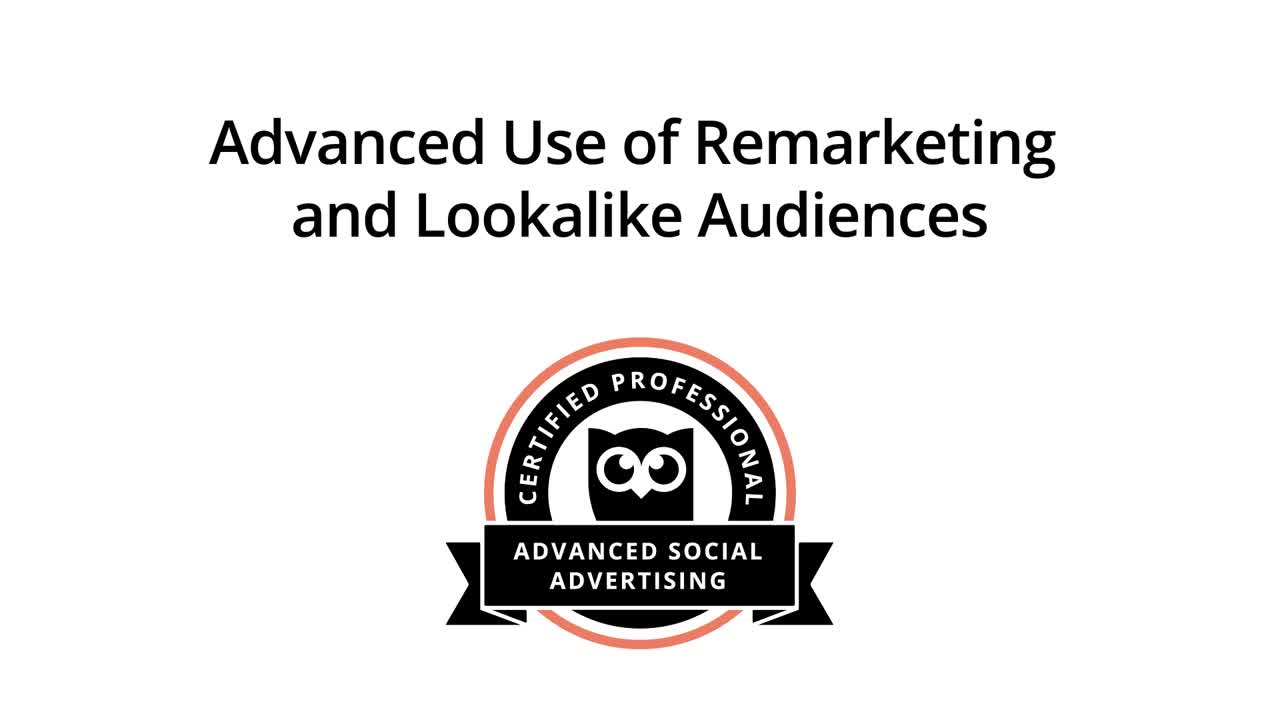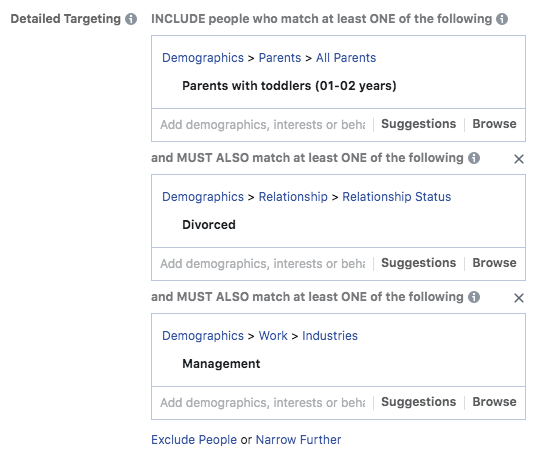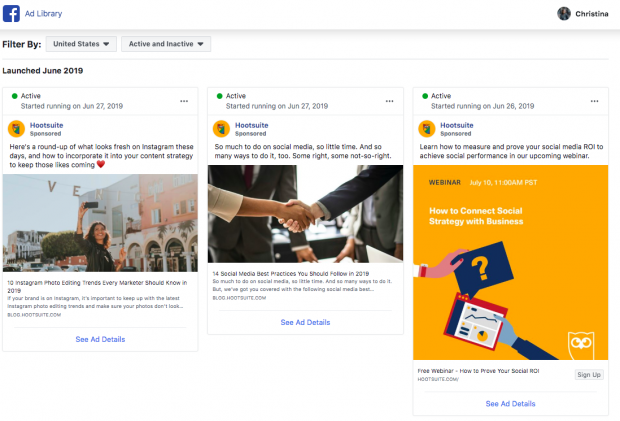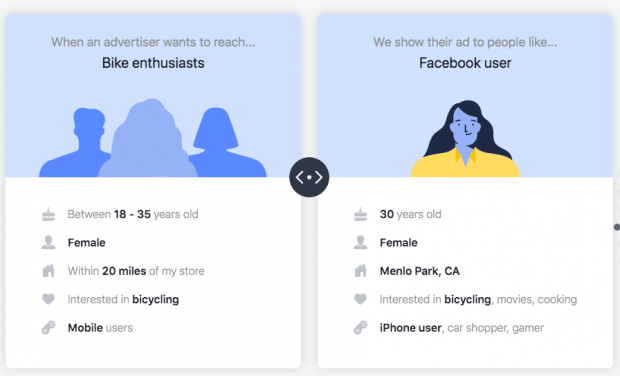Effective Facebook targeting increases ad conversions while lowering the cost per conversion—the ultimate measure of an ad’s value.
Read on to learn the eight targeting techniques you need to improve your Facebook ad performance to get the most out of your budget.
8 powerful Facebook ad targeting strategies for 2019 and beyond
1. Find your unicorn content
Let’s start with a tip about targeting your ad content, before we move into targeting the audience.
If you work in content marketing, you’ve likely already heard the buzz about “unicorn marketing.” But just in case you’ve missed the excitement about this concept coined by MobileMonkey CEO and Inc. columnist Larry Kim, here’s a quick primer.
You may already have heard of the 80/20 rule, which says that 20% of your effort will drive 80% of your results. Kim argues that for content marketing, it’s more like a 98/2 rule.
Only 2% of your content will perform well both on social and in search engine rankings, while also achieving high conversion rates. He argues that content marketing is a volume game, and you simply have to create lots of “donkey” content (you can guess what that means) to get to the unicorns.
So what’s your unicorn content? It’s that blog post that absolutely blows up on your social channels, climbs to the top of the Google rankings, and drives a ton of traffic to your landing pages.
You can’t predict what will “go unicorn” based on factors traditionally used to define great content (like great writing, keywords, and readability). Instead, you’ve got to keep a close eye on your social media analytics and performance.
When you spot overachieving content, repurpose it as a Facebook ad. Make it into an infographic and a video. Test this content in various formats to your key audiences to make it work even harder.
Most important, use the rest of our Facebook ad targeting tips to make sure you match your unicorn content to the audience that’s most likely to engage with it.
2. Target your competitors’ fans using Audience Insights
Facebook Audience Insights offers a ton of valuable information that can help you understand your Facebook followers. You can then use the data to learn how to target potential new followers and customers.
It’s such a treasure trove that we’ve got an entire article dedicated to using Audience Insights for better targeting.
But our favorite Audience Insights strategy is to use the information it provides to learn who you’re competing with on Facebook, then target your competitors’ existing fans.
Here’s a quick how-to:
- Open your Audience Insights dashboard and select Everyone on Facebook.
- Under Create Audience on the left side of the page, use the basic targeting options like location, age, gender, and interests to build an audience that matches your target audience persona.
- Click over to the Page Likes tab to see which pages your target audience already connects with. Copy and paste this list into a spreadsheet or text file.
- Click back to the Create Audience tab and type the name of one of your competitors’ Facebook Pages in the Interests box. Not all competitors will come up as an interest, but for those that do…
- Check out the demographics information on the right side of the screen to see if you can gain any additional audience insights that will help you target yours ads more precisely.
- Create a new audience based on these new demographic insights, then test it against one of your existing audiences.
- Or, simply click Save and you’ve got an audience based on your competitors’ fans.
Of course, you can further target this audience to make sure you get the best fit for your specific business and campaign goals, but this is a great way to start finding relevant people on Facebook.
You can find more details in our Audience Insights how-to article.
3. Use Custom Audiences for remarketing
Remarketing is a powerful Facebook targeting strategy to connect with potential customers who have already expressed interest in your products.
Using Facebook Custom Audiences targeting options, you can choose to show your ads to people who have recently viewed your website, people who have looked at sales pages, or even people who have looked at specific products. You can also choose to exclude people who have purchased recently, if you think they are unlikely to convert again soon.
Before you can use Facebook Custom Audiences based on website visits, you need to install the Facebook Pixel.
Once that’s done, here’s how to create your remarketing audience:
- Go to Audiences with your Ads Manager.
- Click Create a Custom Audience.
- Click Website Traffic.
- Choose your pixel.
- Set your targeting rules.
- Name your audience and click Create Audience.
Find more details in our blog post on how to use Facebook Custom Audiences.
4. Target people similar to existing customers with Lookalike Audiences
Facebook Lookalike Audiences allow you to build targeted lists of potential customers who share characteristics with people who already buy from you.
So, if the data tells you that your existing customers are likely to be mid-30s moms who live in Austin, you can get great bang for your buck by targeting other mid-30s moms who live in Austin.
And that’s a pretty broad example. Facebook’s tools are actually much more sophisticated in their audience matching. Plus, with Lookalike Audiences, you don’t even have to know what data points you’re trying to match. Facebook will figure that out for you.
Bonus: Download a free guide that shows you how to save time and money on your Facebook ads. Find out how to reach the right customers, lower your cost-per-click, and more.
We break down the details in our article on how to use Facebook Lookalike Audiences, but here’s a quick-and-dirty how-to:
- Go to Audiences within your Ads Manager.
- Click Create a Lookalike Audience.
- Choose your source audience. This is the group of existing customers or fans whose characteristics you want to match.
- Select the regions to target.
- Select your audience size. Smaller numbers more precisely match your source audience characteristics.
- Click Create Audience.

Find more details in our guide to Facebook Lookalike Audiences.
5. Get ultra-precise with layered targeting (aka “Narrow Further”)
Facebook offers tons of targeting options. On the surface, the options are divided into three main categories: demographics, interests, and behaviors. But within each of these categories, things get pretty granular.
For example, under demographics, you can choose to target parents. Then you can narrow that target further to specifically target parents with toddlers.
Also under demographics, you can choose to target based on relationship status and job industry.
Now think about what happens when you start combining these layers of targeting. You could choose to target divorced parents of toddlers who work in management. And that’s just looking at demographics.

Under interests, you could target people who are interested in beach vacations. Then, under behaviors, you can specifically target frequent international travellers. Each time you want to add another level of targeting, be sure to click Narrow Audience or Narrow Further.
Do you see where this is going? If you run a high-end beach resort that offers a childcare program and no single supplement, you could create a promotion that specifically targets single parents in management-level jobs who love beach vacations and travel frequently.
If you market products or services tied to life events, even tangentially, you can target people who have recently moved, started a new job, gotten engaged or married. You can target people on their birthday, or leading up to their anniversary. You can even target people whose friends have an upcoming birthday.
As you build your audience, you’ll see on the right side of the page how small your audience has become, as well as your potential reach. If you get too specific, Facebook will let you know.
This strategy works best for specific promotions designed to target a precise audience, rather than ads to promote your business in general. Combine this precise Facebook ad targeting with a landing page that speaks directly to the exact audience for best results.
6. Try combining two unique audiences together
Of course, not every product or promotion is naturally suited to the kind of precise Facebook targeting explained in the tip above.
Maybe you don’t know what specific demographic or behavior categories you want to target with a specific ad. You only have a broad sense of a category you’d like to target. So, what do you do if that target audience is just too large?
Combine it with a second audience, even if that second audience seems completely unrelated.
For example, let’s think about creating an ad audience for Hootsuite’s epic Game of Social Thrones video.
To start, we could build an audience of people who are interested in digital marketing, online advertising, social media, or social media marketing. Even limiting the audience to people aged 22 to 55 in the United States, that creates a potential reach of 160 million people. That’s just too broad.
Now, there’s no obvious connection between social media marketing and Game of Thrones, but in this case the ad creative is a Game of Thrones video. So, what’s the obvious audience to ad in here?
Yep, Game of Thrones fans.
That cuts the potential audience size in half. And it’s likely to result in a much higher engagement rate, since people who see the ad will be in on the joke.
In this case, we worked backwards from an existing piece of creative. But you could also decide on two unrelated audiences to combine, then create a targeted piece of content to speak directly to that group.
7. Check Ad Relevance Diagnostics for opportunities to improve targeting
In early 2019, Facebook replaced its relevance score with three new “ad relevance diagnostics”:
- Quality ranking
- Engagement rate ranking
- Conversion rate ranking
As Facebook says, “People prefer to see ads that are relevant to them. And when businesses show their ads to relevant audiences, they see better business outcomes. That’s why we consider how relevant each ad is to a person before delivering an ad to that person.”
The whole point of Facebook ad targeting is to get your ad in front of the specific audience that’s most likely to take action based on that exact ad. This is the very definition of relevance.
We’ve got a whole article dedicated to ways to help you improve your ranking scores for Facebook’s ad relevance diagnostics. Here are some quick highlights:
- Focus on quality, including great visuals and short copy.
- Choose the right ad format.
- Aim for low ad frequency.
- Time ads strategically.
- Optimize your ads with A/B testing.
- Keep an eye on your competitors’ ads.
If your ads aren’t performing as well as you like, you can use the ad relevance diagnostics to look for opportunities to improve targeting:
- Low quality ranking: Try changing the target audience to one that’s more likely to appreciate the specific creative in the ad.
- Low engagement rate ranking: Refine your targeting to reach people who are more likely to engage. Audience Insights can be a great help here.
- Low conversion rate ranking: Target a higher-intent audience. This could be as simple as selecting “engaged shoppers” under purchase behavior. But it could also mean targeting people who have an upcoming anniversary, or who have another behavior or life event that make your product or service particularly relevant to them right at this moment.
Remember, relevance is all about matching the right ad to the right audience. No one ad will be relevant to everyone. Effective targeting is the only way to achieve a consistently high relevance ranking.
8. Don’t be a jerk
This may sound obvious, but there are a couple of things you should definitely NOT do when targeting your Facebook ads. These things can damage your relationships with Facebook, and with your potential customers.
So, to make the most of your Facebook ad targeting, definitely do not do the following.
Don’t upload purchased lists of email addresses
First of all, this is against Facebook’s Custom Audiences terms of service.
Second, Facebook users can see which businesses have “uploaded a list with your info and advertised to it.”
When I look at this list for my personal account, it’s clear that hundreds of real estate agents across North America are using a purchased list that includes me. I won’t shame them by sharing a screencap, but I can assure you they’ll never get my business. (I wasn’t particularly likely to need a realtor in Aspen or Ann Arbor or Las Vegas, anyway.)
Don’t think your targeted ads are private
When you use Facebook ad targeting options to select the audience for your ad, you only pay to show it to the groups of people you’ve selected. But they are not the only ones who can see your ad.
Any Facebook user can see all the ads you run if they visit your Ad Library, accessible through your Page’s Page Transparency section. Here’s an example of the Hootsuite Ad Library:

Just remember that any potential customer can see all your ads, even if you don’t target them. Keep this in mind when deciding what kind of images and messaging you want to include in your ads.
The key message on both these points is that your behavior as an advertiser is visible to everyone on Facebook.
So, play nice and don’t be a jerk.
Facebook ad targeting 2019 changes to terms of service
Facebook announced that it will be updating its terms of service at the end of July 2019 to make it more clear how personal data is used for ad targeting. Here’s how they spell it out for Facebook users:
“We don’t sell your personal data. We allow advertisers to tell us things like their business goal, and the kind of audience they want to see their ads (for example, people between the age of 18-35 who like cycling). We then show their ad to people who might be interested.”

They also explain the details of ad performance reporting:
“We provide general demographic and interest information to advertisers (for example, that an ad was seen by a woman between the ages of 25 and 34 who lives in Madrid and likes software engineering) to help them better understand their audience. We don’t share information that directly identifies you (information such as your name or email address that by itself can be used to contact you or identifies who you are) unless you give us specific permission.”
None of this changes how Facebook ad targeting actually works. But it’s good for both advertisers and Facebook users to have a clearer picture of how personal data is used (and not used) to target ads.
Get the most out of your Facebook ad budget with Hootsuite Ads. The powerful tool makes it easy to create, manage, and optimize Facebook ad campaigns. Try it free today!